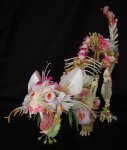Campbell
Relaxed Intensity
I think there is a certain incoherence between using skill challenges as the primary method to deal with non-combat challenges and the discrete and detailed ritual system. My solve for this incoherence is generally to ignore the existence of rituals, and allow supernatural effects to be generated from Arcana, Religion, and Nature used with appropriate fictional positioning to preserve the close scene resolution of skill challenges. In my opinion this is one area where 4e suffered from having too many cooks in the kitchen. In many ways it was afraid to go full indy.
I also would like to point out that while I believe the intent of 4e monster stat blocks was not to necessarily encapsulate the full extent of a creature's ability there are several instances where non-combat abilities are detailed in the stat block such as the Doppelganger's Change Shape ability, The Flameskull's Illumination ability, the Trap Haunt's Trapbound ability, or the Dryad's Deceptive Veil ability. I personally would have liked to see more monsters with such abilities, but I don't think the stat block should have to represent the full extent of it's abilities.
Of course, none of the above has anything to do with desiring more dynamic monsters in 5e, both when it comes to combat and outside of combat. It also has nothing to do with the desire to have better tools for constructing encounters or creating monsters. It has nothing to do with the desire for more mechanical rigor. It also has nothing to do with wanting lore that is focused on being used in play. If you want to discuss where 4e faltered, we can do that. I personally have no desire to go back and have those arguments again. I would much rather focus on what ideas can be taken from the things 4e did well to improve the current edition of the game.
I also would like to point out that while I believe the intent of 4e monster stat blocks was not to necessarily encapsulate the full extent of a creature's ability there are several instances where non-combat abilities are detailed in the stat block such as the Doppelganger's Change Shape ability, The Flameskull's Illumination ability, the Trap Haunt's Trapbound ability, or the Dryad's Deceptive Veil ability. I personally would have liked to see more monsters with such abilities, but I don't think the stat block should have to represent the full extent of it's abilities.
Of course, none of the above has anything to do with desiring more dynamic monsters in 5e, both when it comes to combat and outside of combat. It also has nothing to do with the desire to have better tools for constructing encounters or creating monsters. It has nothing to do with the desire for more mechanical rigor. It also has nothing to do with wanting lore that is focused on being used in play. If you want to discuss where 4e faltered, we can do that. I personally have no desire to go back and have those arguments again. I would much rather focus on what ideas can be taken from the things 4e did well to improve the current edition of the game.
Last edited:




